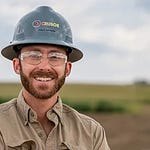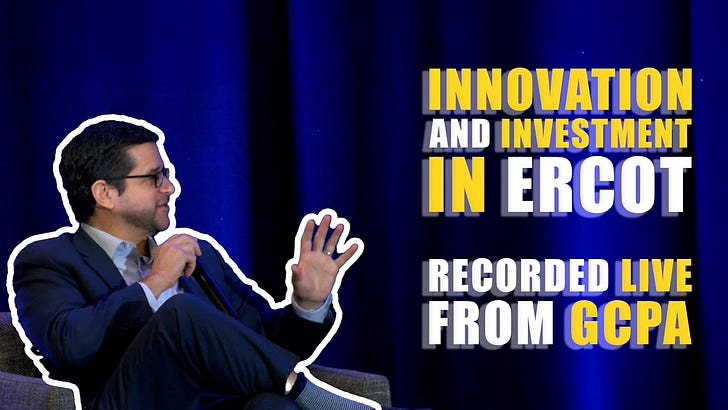Most solar panels are imported from China which now has the ability to manufacture over a terawatt (1,000 gigawatts) of solar modules every year — roughly equal to the entire installed base of generation in the US inclusive from every energy source.
America makes less than 1/20 of that amount and even less when it comes to the more difficult task of manufacturing cells.
But Texas is known for manufacturing and T1 — short for Type 1 civilization — is building solar manufacturing in Texas that could change the game.
This is about energy abundance that is reliable, local, and affordable.
As T1 CEO Daniel Barcelo told me:
“I’ve been working in oil and gas and I am an old oil and gas guy who has run oil and gas companies globally. At the end of the day, it’s really about providing the lowest cost energy in whatever form it is and delivering that energy at a cost-competitive basis to the customer. That drives the philosophy at T1.”
T1’s plan is straightforward and ambitious: a multi-site Texas footprint that connects a domestic solar manufacturing chain from materials to finished modules. The company has a module assembly plant in Wilmer in the Dallas area, and is developing cell manufacturing in Rockdale in Central Texas. Upstream, they’ve lined up domestic polysilicon supply from Corning to feed those lines.

While T1 scales up supply, demand for power is surging.
Texas electricity use is rising rapidly, driven mostly by oil and gas demand, cryptocurrency mining, industrial electrification, and data centers. Texas demand is up 23% in the last four years; most of that new demand is being met by solar power.
When more of the equipment is made here, projects move faster and carry less supply-chain risk. And solar can be scaled very quickly to meet near-term needs.
“AI needs energy. Data centers need energy. They need it now. It’s great to build nuclear plants in 2030. That’s awesome. But the world’s not waiting. And the big tech companies are not waiting. And right now, solar and storage can deliver it.”
This is not either-or. Texas has long succeeded by adding the next tool that works. Solar plus storage are tools for growth and we should use them.
Domestic manufacturing creates jobs and strengthens our energy security and global competitiveness.
Texas has never waited for someone else to build our future. If companies like T1 can stand up the full stack here, we get more than panels.
We get speed, security, control, and the ability to match ERCOT’s needs with Texas-made solutions.
If you found this episode useful, share it with a colleague. If you want more Texas-first, reality-based energy coverage, subscribe and join the conversation.
Timestamps
00:00 – Introduction
02:00 – T1’s Texas footprint overview
04:00 – U.S. solar chain, Corning partnership
05:30 – Jobs and polysilicon-to-module flow
07:00 – Building U.S. cell capacity
09:00 – Timelines and receptivity of Texas political leaders
11:00 – Demand growth requires gigawatts per month
13:00 – Competitive advantages of building in Texas
15:30 – Oil and gas demand growth met by solar and wind, saving $1/barrel
20:30 – When King Coal tried to kill natural gas and why gas won
23:00 – Political economy of varying energy sources
25:30 – Can the US build enough solar to meet domestic need and export?
31:00 – Solar trade investigations, tariffs, anti-dumping rules, FEOC
35:00 – Solar and manufacturing tax credits under OBBBA, “stackability”
38:00 – How and why tax policy benefits all energy, including oil and gas
42:00 – Will Texas continue to blaze trails and attract new energy companies?
45:00 – Distributed power is “sovereign energy”
Resources
Guest & Company
• Daniel Barcelo — LinkedIn
• T1 Energy — Company Website + LinkedIn
Company & Industry News
• Reuters: T1 Energy and Corning agree to fully U.S.-made solar supply chain
• PV Tech: T1 Energy–Corning “landmark” U.S.-made poly/wafer/cell deal
• Manufacturing Dive: T1 to establish $850M solar cell facility in Texas
• T1 Energy IR: Corning deal accelerates ‘Made in America’ solar
• T1 Energy IR: Strategic investment in Talon PV
Related Articles & Podcasts
• How Batteries Are Reshaping the Texas Grid (with Suzanne Leta)
• Beyond the Tax Credit Cliff (with Freedom Solar CEO Bret Biggart)
• Creating a Distributed Battery Network (with Zach Dell)
• The End of Solar & Battery Manufacturing in America?
Studies & Policy Documents • S&P Platts 2022 Study On Electrification of the Permian Basin • Rystad Study on $/barrel savings • FERC Order 636 • Section 232 Investigations • Foreign Entity of Concern Guidance | Dept. of Energy
Doug’s Platforms
• LinkedIn
• YouTube
• X (Twitter)
Transcript
Doug Lewin (00:05.25)
Welcome to the Energy Capital Podcast. I’m your host, Doug Lewin. My guest this week was Daniel Barcelo, the CEO and chairman of the board of T1 Energy. We talked about how they got their name in this episode. I think you’ll enjoy that. This is a fascinating company, headquartered in Texas. They are building out a full end-to-end manufacturing of solar in Texas. They started with the acquisition of a manufacturing plant, five gigawatts of solar module assembly in Wilmer, Texas, just south of Dallas. They are currently building in Rockdale, Texas, about 60 miles north of Austin, a cell manufacturing facility. So obviously cells are much more complicated to manufacture, much more complex than the module manufacturing. They are also in partnership with Owens Corning to get the raw materials actually sourced here in America. So that when they are done with that process in a year or two, they will have end-to-end American solar manufacturing. So we talked a lot about the potential for American manufacturing of solar, how big it is now, what its potential is to maybe counterbalance China, which is really dominating electricity supply chains throughout a whole number of different components, including all parts of the solar supply chain. They’re dominating that globally. Can America be a counterbalance? One of the things I really enjoyed about this conversation is Daniel has a great perspective, having worked in oil and gas for much of his career, really at the broad spectrum of energy. So I think that really comes through in the interview. I think you’re going to enjoy that.
This is a paid episode. If you’re not already a paid subscriber, please become one today. You’ll get access to all sorts of things, roundups, reading your podcast picks, other paid episodes of the Energy Capital Podcast. Most importantly, you will be supporting the work of this podcast, the Texas Energy and Power Newsletter. They are not cheap to produce, and your six bucks a month or five bucks a month if you do an annual subscription is incredibly important, deeply appreciated. With that, let’s jump into the episode with Daniel Barcelo of T1.
Daniel Barcelo, welcome to the Energy Capital Podcast. I am very excited to talk to you. T1 is making a whole lot of waves, people in Texas talking about the company a lot. Why don’t we just start from the beginning. What is T1 and tell us about the Texas operations you guys are standing up.
Dan Barcelo (02:31.8)
Great. First of all, Doug, thank you very much for having us. We’re always excited to talk about the T1 story, something we’re really passionate about as energy operators, managers, investors, historically. T1 Energy is building a domestic solar and battery supply chain that we want to invigorate America with clean, scalable, reliable, and low-cost energy. This is all about advanced manufacturing. This is about how do we bring advanced manufacturing capacity to unlock the most scalable resources we have. That’s what we’re doing. We’re doing this with our core foundational assets. We own and operate our five-gigawatt solar module plant just south of Dallas. That’s called G1 Dallas. And we are also building our five-gigawatt solar cell plant north of Austin called G2 Austin. Those two assets are foundational. The other part of the investments we’ve made is we also own a supply chain of polysilicon from Hemlock. Coupling that polysilicon supply chain coupled with the cell plant, coupled with the module side, we have a tremendous capacity to unlock what we think is a very scalable, renewable power asset we have available right now.
Doug Lewin (03:42.39)
Yeah, it’s pretty exciting because I see the vision of what you’re trying to do here, right? Because what we have in the United States right now, if I’m not mistaken, and you correct me on any of this I get wrong. This is your world. But my understanding is we’ve got something like 50 to 60 gigawatts of capacity of solar module manufacturing. So that’s sort of the last phase where you’re bringing the assembly, kind of bringing it all together. But you guys are going way upstream to raw materials. And you mentioned something just there. I’m not sure I heard what you said, but I do want to get more into this. I think you guys announced a deal with Corning, right? For some of the raw materials. Not sure if that goes through to the wafers, but I do kind of want to break that down a little bit, Dan, because I think the audience will really appreciate it.
It’s very important. I think it’s very important that the United States have the full end-to-end capability for manufacturing. And it looks to me like you guys are doing that with the partnership of Corning upstream, then actually making the cells, correct, in Rockdale, which is what you’re calling the G2 Austin plant, close enough, like 50 miles or so from Austin. I believe near the old Alcoa site, we could talk some about that. And then putting it together in Wilmer, south of Dallas. So you’re really kind of doing that like soup to nuts end-to-end, full supply chain, no?
Dan Barcelo (05:04.034)
Yeah, look, when we acquired these assets at the end of last year, what we acquired was, at that point in time, the world’s most modern solar module manufacturing facility. And that’s operational, that’s up and running.
Doug Lewin (05:17.954)
That’s Dallas, right?
Dan Barcelo (05:20.162)
Dallas. That is this five-gigawatt solar module manufacturing G1 Dallas. It is one of the world’s most modern facilities up and running ready for business. Highly automated yet also employs a good number of people, over a thousand people workforce and a very large payroll as well in the South Dallas community.
Doug Lewin (05:39.378)
Dan, that thousand jobs is current or that’s projected?
Dan Barcelo (05:43.064)
That is current. Currently, a thousand Texans employed in South Dallas. That’s correct. We’re currently over 1,200. And with the acquisition, we also acquired a polysilicon supply agreement to supply gigawatts of polysilicon to be the initial part of the chain. Now we did announce earlier that we have the arrangement and the contracts with Hemlock to convert that polysilicon contract in part to wafers. So in order to complete the chain, you’re basically taking the polysilicon, which is ingots and then wafers. Then you’re taking the cells and then you’re taking the modules to the module of the solar panel. So when you think about the solar chain, you’re going from the polysilicon, ingots and wafers, cells, and modules. What this acquisition did was we purchased the module plant, which just gets us to the end customer use. You mentioned the market size of 50 to 60 gigawatts. This plant is about 10% of the U.S. On the polysilicon side, we wanted to secure American polysilicon in order to supply an American module plant. Until we have our solar cell plant up and running, we currently are sending our polysilicon to Southeast Asia in order to make wafers and cells and then bring those cells back to the United States. By the fourth quarter of 2026, we anticipate to have our G2 Austin site up and running. And at that point, what we’ll be doing is taking wafers from Corning, bringing those wafers to G2 Austin, and then making the cells and then taking those cells to G1 Dallas to make the modules.
Doug Lewin (07:17.838)
Amazing. And my understanding, and this may be a couple months old, but I don’t think it’s terribly out of date, there’s really only like a gigawatt or maybe two of solar cell manufacturing in the United States. When you say you’re 10% of the module assembly in the Dallas plant, that Austin plant, when it comes online, will represent... Maybe by that time there’ll be others and maybe I’m missing some or I’m just getting it wrong, but that’s a huge percent of the entire capacity of the United States, right?
Dan Barcelo (07:46.376)
The cell capacity is higher. It’s above 10 gigawatts. There are differences in that capacity. There is capacity from different technologies which are non-silicon based. There’s also technologies of cells that are older PERC style. This will be TOPCon technology based and is one of the most modern and most energy efficient technologies.
Doug Lewin (08:08.302)
So that’s First Solar is like the other 10 gigawatts basically, right?
Dan Barcelo (08:12.33)
That’s correct. First Solar and then there’s others on the PERC side and that technology. But on the silicon-based TOPCon, this will be one of the first. So with that TOPCon technology, that provides better efficiency, it provides better in terms of what customers want, in terms of energy density, in terms of deployment. So that’s our focus.
Doug Lewin (08:32.716)
Okay, incredible. And I will put some links in the show notes, stuff like this. The capacity of China is orders of magnitude more. Like I said before, I think this is really important that this start to happen in the United States. It’s going to take a while for this to all scale up, but this is obviously a huge step in the right direction. What is the reception in Texas? You’re obviously, I’ve seen you post on social media various visits to the plants by various elected officials. You know, obviously there’s a notion out there that at least, well, and it’s true, that some in Texas political leadership are hostile to renewables. But I think by and large, there’s an awareness out there that oil and gas and renewables actually can have kind of a symbiotic relationship. Curious, you’ve written about that on LinkedIn, so I would love for you to talk about that. So there’s really two questions there. Sorry I do this, I do these multi-part questions. But really, what is the reception from political leadership been and what do you see as sort of the future of Texas energy with sort of the coexistence of oil and gas versus renewables? Where do they compete? Where are they symbiotic?
Dan Barcelo (09:39.64)
Sure. Well, first of all, the reception has been phenomenal. Whenever anyone’s bringing in a large payroll, a large labor force, and also bringing in newer, advanced manufacturing jobs, that is something I think everyone across the political aisles can agree on and see as a good thing for the United States. Bringing supply chains back to the United States are also very important, and I think all of that is resonating. There’s the obvious tensions and competitive tensions we all see and read about with China versus the USA. So having more of the energy manufacturing and having more of the energy security based in the U.S., that’s all positive. So it’s resonating from Washington to the state, to the local levels. So that has been very, very clear and very consistent. Now, I kind of grew up in the oil and gas sector. Since the early ‘90s, I’ve been working in oil and gas and I am an old oil and gas guy who’s done capital markets on that and run oil and gas companies globally. At the end of the day, it’s really about providing the lowest cost energy in whatever form it is and delivering that energy at a cost-competitive basis to the customer. That drives the philosophy at T1. I almost shrug or shudder when I hear the word renewable sometimes. I think it’s done a disservice to the solar industry. It’s done a disservice to the wind industry. This is just conversion of materials to electrons to enable power, to enable electricity. And I think that solar and solar plus storage can be an incredible competitive advantage versus other sources of fuels. I spent years drilling natural gas wells in order to get gas to create power, the power from the generators, right? This is very similar to me. Now we’re spending years and capital to create machines that from the silicon sources of polysilicon create the machines and the panels to make electricity. So it’s either drilling or finding the gas to feed the turbines to make the power, or it’s putting up the machines and finding the silicon, the polysilicon to make the electrons. So in my mind, this is all about delivery of energy to the market and the market needs it.
The demand growth right now that we’re seeing in the U.S. is unprecedented. It is driven by small amounts of residential growth, but it’s driven by industrialization and it’s obviously driven by the rise of AI and data center loads. The only source of power that can match the ramp that AI wants is solar and batteries, at least for the next four years. If we’re going to be very competitive over the next four years, as hopefully people a lot smarter than me try to go for the AGI and try to get to that level of where we can be as a society, the gigawatts per week, gigawatts per month is what everyone’s talking about. The plant we have at G1 can produce five gigawatts a year. If I had the demand signals, I could create another plant like this within a matter of another year. We are able to deliver gigawatts and gigawatts of solar. Some will say, well, it’s interruptible power. Well, you know, when you look at where demand is, demand is kind of interruptible too. As we know in Texas from three o’clock to seven o’clock, it’s a very different load profile than three o’clock to seven o’clock at night. So the matching of demand is something I think that does a disservice. And once you put batteries and grid level batteries on, we see it in ERCOT all the time. We see it in CAISO in California all the time.
The grid is more robust when batteries and solar are part of the grid, full stop. So we think that batteries, and to be clear, we used to do batteries, we have paused on the batteries now, we aim and strive and have ambitions to batteries in the future. Right now it’s all about the solar and it’s all about supplying that supply chain. The last part of this is all of that’s great, but I believe that we can build this in the United States. And I don’t believe this is anything we’ll say less competitive or that we don’t have versus other places. Let me just expand on that in a moment. When we look at the automation of the machines we’re buying and the ability for these machines to run, fundamentally we’re turning silicon to polysilicon to wafer to a cell to a module. This is just the transformation of materials into something that collects photons to create electricity. The largest conversion costs of all of that has to do with water, has to do with electricity. There’s some specialty gases. There’s in the case of the modules, there’s frames and there’s glass. But fundamentally, these are all very commoditized products. Texas is very lucky to have extremely competitive electricity prices, extremely competitive water prices, extremely competitive specialty gas prices, and extremely competitive natural gas prices.
So what this is getting distilled down to is a labor cost differential. Given the high automation, both the module plants, the cell plants, the wafer plants, that labor component is less and less and less. So I believe that we’re actually seeing a competitive advantage now where these machines can be here. There’s still a higher labor cost structure than in other parts of the world. That goes to the wages America pays its employees and the good wages and the living wages. It probably also ties into a bit on how wastewater is treated, which is probably much more important when we talk about what the impact the solar industry or data center or other people can have is the immediate impact right now on wastewater. So those two parts are probably the highest differential in cost relative to the rest of the world. When I build, for example, in G2 and Rockdale, those machines that come in and that are building there, those machines don’t know if they’re in Egypt or Turkey or Nigeria. They have no concept of where they are. Those machines just know they need power, water, and they need wafers. So that’s where we get to how we can be more competitive.
Doug Lewin (15:23.8)
You mentioned load growth from AI. In preparing for this, I missed it at the time, but I’m going to follow your LinkedIn more closely now. You had a post a couple months ago that I thought was really extraordinary. It was specifically about oil and gas. So yes, we have a lot of load growth from AI that is already hitting the system and more to come. The far west zone in Texas has tripled its energy consumption over the last eight years, a tripling in eight years. And some of that is Bitcoin, cryptocurrency, there’s probably some initial AI, but there’s a whole lot of oil and gas load as well that is connecting to the grid.
And a few years ago, six of the biggest oil companies operating in Texas went in together on a study from S&P Platts and showed their kind of demand growth curves that there’s already, I think, four gigs or so of grid-tied oil and gas sort of fracking operations, but also compressors and all the rest, that that could go as high as 10 to 12. And this was just in the Permian, I believe just in the Texas. You were writing about this. And again, you referenced that you and other executives at T1 have spent much of your careers working in oil and gas. And you put in there that last year more than 88% of the electricity produced there, meaning I believe you meant in Permian, you may have meant far west zone, was from solar and wind farms, according to an analysis of the actual electricity production last year.
That is extraordinary. I’ve never seen that number before, but it kind of makes sense when I sometimes will post on social media or in my articles, like the overlay of where the Permian is geographically, obviously in far west Texas, sort of where the right angle of Texas and New Mexico meets, kind of just to the east of that and to the south of that. And then if you look at that right next to maps of where the sunniest parts of America and the windiest parts of America are, it’s all right there. Can you talk a little bit more about what you’re seeing in the oil and gas? Are you having conversations with people in that industry that are like, we’re trying to purchase more renewables. Can you get some of your solar panels out here? Are you hearing that kind of chatter from folks you know that are still in that?
Dan Barcelo (17:33.11)
Look, part of it is geography. Southern and Western Texas, all the way to California is blessed with a lot of great solar in terms of radiation levels. And in terms of wind, you have straight down the center and through West Texas, you have wind. So you have a lot of overlapping wind and solar power and it makes West Texas extremely, extremely valuable in terms of that resource. So again, I almost would drop the word renewable. This is as simple as according to, I think we use Rystad in that study. There’s about a dollar per barrel in terms of BOE equivalent of savings that companies could make by removing their power from the grid and using electricity rather than running gas turbines or diesel generation, which is expensive. So the idea is how do you produce and sell more of the product you’re making rather than use it to run your turbines with your diesel. So by using power from the grid there, there was a savings about a dollar per barrel. When you look there, I think the numbers there were growing to around eight gigawatts today. And according to Rystad, there was an increase of a further three gigawatts on the Texas grid just from the Permian. So it’s just making an example that in order to produce even the oil and gas, in order to lower operating and lifting costs, the switch is to go to grid power, which is primarily renewables, which is primarily wind and solar.
And again, this goes to just the cost nature of it. So even oil and gas, which in that area, a third to half of production of the U.S., it’s phenomenal levels of production. Those resources can be produced. Those resources can be used for better energy and chemicals and plastics in the United States, or they can be exported, so to speak, to export American exceptionalism in that form in terms of energy exports. So I think there’s a lot of combined ability for it. The benefit the ERCOT grid gets from solar and even from wind is it’s driving energy costs lower. And you mentioned this before that maybe there’s some biases in terms of left and right, in terms of wind and solar versus oil and gas. But if you look at Texas, it’s just making an example of what can be built now, what’s economic, how do we build it fast? So I think those are the key drivers. So we flag that as, it’s a great example of how it’s just energy and the cheapest forms of energy and the most efficient forms of energy are there supporting the largest forms of exports of American oil.
Doug Lewin (19:48.622)
Yeah, I actually love that framing or reframing that we often get so much into the label that goes in front of the word energy, the adjective, the modifier, instead of focusing on the energy itself. And this is what is great about Texas is you do have this system of economic dispatch and it’s going to be the lowest cost energy. And that typically happens to be wind and solar, but it’s not because it’s wind and solar. It’s not because it’s renewable. It’s not because of some attribute other than it’s cheaper. That is really what kind of is driving its adoption. So that’s fascinating. A dollar per barrel is not insignificant. That could be even a couple of percent when we’re down in the $50 to $60 range.
Dan Barcelo (20:31.982)
So when I started my career in the early ‘90s, it was the era of FERC 636 with open access for natural gas. That was when coal dominated all electricity production and King Coal tried to kill natural gas.
Listen to this episode with a 7-day free trial
Subscribe to The Texas Energy and Power Newsletter to listen to this post and get 7 days of free access to the full post archives.














